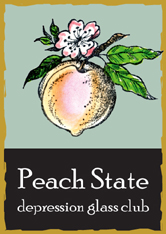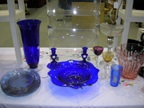Glossary of Glass
The definitions below are intended only as brief introductions to the types of glass that historically have appeared at the Annual Collectible Glass Show and Sale presented by the Peach State Depression Glass Club. The list is by no means exhaustive.
Blenko Glass Co.: Still in business in Milton, WV. Noted for vibrant colors and large size pieces which are mold blown (see blown glass).
Blown Glass: Hand – made from molten glass. Either shaped freehand or blown into a mold.
Carnival Glass: Pressed (machine made) and iridized glass originally made from 1905 to 1940. The finish is sprayed on and then fired. United States companies that produced it include; Fenton, H. Northwood, Dugan & Diamond, Imperial, Millersburg, Cambridge, Westmoreland, Fostoria, and U.S. Glass Co. In the 1970s, Fenton re-introduced Carnival.
Crackle: Glass that has been treated to give its surface an overall cracked texture. This treatment is done by immersing the hot piece in cold water. The sudden temperature change causes the glass to crack. It is reheated to smooth the irregular lines of crackling. Some glass companies that have produced crackle are Bischoff, Blenko, Kanawha, Pilgrim, Rainbow, and Viking.
Depression Glass: Machine made, dime store or give-away glass manufactured from the late 1920s to 1940, mainly in the colors of blue, pink, amber, black, colorless, green, red, yellow, and white. Some of the manufacturing companies are Jeannette, New Martinsville, Imperial, MacBeth-Evens, Indiana Glass, Paden City, U.S. Glass, Hazel Atlas, Westmoreland, Hocking, Federal, Bartlett-Collins, Lancaster, Mckee, Fenton, Anchor Hocking, and L.E. Smith.
Elegant Depression Glass: Hand worked glass made during the Depression through the 1950s and sold at higher end stores than depression glass was. Some of the Elegant D.G. producers were Cambridge, Fenton, Heisey, Tiffin, Duncan & Miller, Morgantown, and Consolidated Lamp & Glass.
Fenton Art Glass: Still in business in Williamstown, W.V. Noted for many types of glass, including carnival, chocolate, opalescent, stretch, milk, “crested” glass, Vasa Murrhina, Burmese, and Rosalene.
40s, 50s, and 60s Glass: The inclusive term for collectible glassware, both machine and hand made, from those years. Many of the glass companies that had produced carnival, D.G. or Elegant D.G. continued with new patterns through the 1960s.
Machine made glass: As the term implies, automated production in huge quantities.
Opalescent Glass: Glass made by a process that turns portions of the piece milky when it is fired a second or third time. The initial period of production was 1880 – 1920, but the Fenton Art Glass Co. has made opalescent off and on up to now.
Pattern Glass: Machine made glass whose history goes back to the middle 1800s and continues through the 1920s. There were many, many manufacturers and hundreds of patterns. Two popular patterns are Three Face and Westward Ho.
Slag Glass: Glass made by swirling together 2 or more colors, generally white opaque Milk Glass and a colored glass, such as red, purple or green. Some American companies that produced slag are Imperial, L.G. Wright, Westmoreland, and Fenton.
Submitted by Deborah Allen



